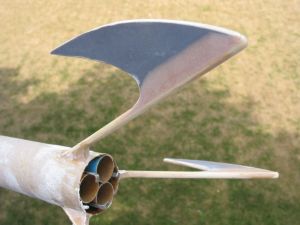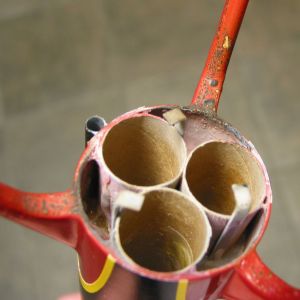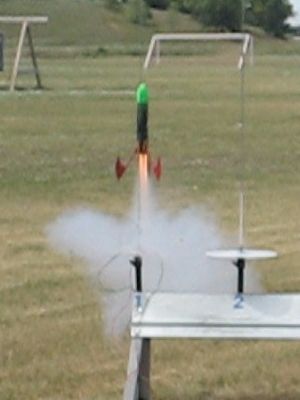Modification BioHazard Modification
Modification - BioHazard {Modification}
Contributed by Dwayne Shmel
| Manufacturer: | Modification |

Brief:
This is a kit bash of a Baby Bertha that transforms a mild mannered rocket into mean, green, flying machine--the BioHazard.
Modifications:
One challenge was the tight fit of three 18mm motor mount tubes inside the BT-60 body tube. The 3 tubes were glued together and the inside "hole" was filled with a dollop of epoxy with a little paper wad as a backer. The 3 motor tube assembly fit inside the BT-60 with all the tubes making contact for a perfect fit. I made a custom "centering ring" consisting of 3 separate wedges to basically fill in the triangular spaces between the outside of the 3 motor tubes and the main body tube. The whole assembly was glued in placed. I could have used the same wadding and glue fill that I used in the center but wanted something was less messy and a little lighter.
I used Bondo to smooth out the body tube to wooden dowel transition as well as the dowel to fin transition. Finishing was accomplished by paper laminating the fins to fill in the grain (paper applied before assembly) and lots of fill and sand. After a few coats of gray primer, I painted the whole rocket with 3 coats of bright red.
 The main body tube was finished using artwork printed on a full sheet of high resolution adhesive backed ink jet paper. I downloaded the biohazard symbol and "dripping goo" art from the web and composed the wrap in PaintShop Pro. I calculated the required size for the wrap and printed some test sheets to make sure the beginning and ends of the "decal" lined up. After printing the label, I fixed the ink with clear sealer and let it dry. For added water resistance, I mixed up some epoxy and "trowelled" it onto the paper and then wiped it back off. This made the paper almost like vinyl and deepened the colors. After cutting out the sections around the fin dowels that I wanted to remain red, I carefully applied the wrap to the body tube. I then airbrushed the nose cone a bright florescent green and epoxied on the launch lugs.
The main body tube was finished using artwork printed on a full sheet of high resolution adhesive backed ink jet paper. I downloaded the biohazard symbol and "dripping goo" art from the web and composed the wrap in PaintShop Pro. I calculated the required size for the wrap and printed some test sheets to make sure the beginning and ends of the "decal" lined up. After printing the label, I fixed the ink with clear sealer and let it dry. For added water resistance, I mixed up some epoxy and "trowelled" it onto the paper and then wiped it back off. This made the paper almost like vinyl and deepened the colors. After cutting out the sections around the fin dowels that I wanted to remain red, I carefully applied the wrap to the body tube. I then airbrushed the nose cone a bright florescent green and epoxied on the launch lugs.
Construction and Finishing:
I started with a basic Bertha BT-60 body tube and nose cone but wanted something that looked threatening for the lower section of the rocket. I also wanted something fast so I went with a 3 cluster 18mm motor configuration. I used RockSim to design a 3 sickle fin design to mimic parts of the international symbol for a biohazard. I tweaked the fins shape and standoff dimensions for proper stability, printed out the patterns, and cut them out of 1/8" balsa stock. The fins are mounted below and away from the rocket body on wooden dowels that go though the body tube and extend to the motor mount tubes. Generous amounts of epoxy are used to mount the fins to the dowels and the dowels to the body tube. I decided to use a Kevlar® shock cord epoxied to the inside of the body tube which in turn is attached to a standard elastic cord to soften the ejection shock. I used double 1/8" launch lugs to distribute the friction and torque.


The use of paper lamination provides limitless possibilities for finishing the rocket. The tricky part is in the preparation of the artwork and the application of the paper to the tube or fin. One the paper makes contact, it is difficult to remove without tearing or fouling the substrate. You also have to experiment with different sealers to ensure you don't use something that makes the paper translucent like wax paper. I found the cheap Wal-Mart brand clear sealer works best. I also make sure that I paint the surface white first if I have a wrap or lamination that has white or light colors. This keeps blemishes from being visible under the paper.

Flight and Recovery:
I flew this rocket on a 3 motor cluster of A8-3s. Wow. It took off! The rocket deployed nose cone up at apogee with all three motors ejecting about the same time. I packed the rocket full of cellulose wadding so the 12" plastic chute survived the ejection charge and brought the rocket down at a good but not fast pace. The use of copious amounts of epoxy make the fins strong (as does the paper lamination) so there was no damage even after landing on hard dry ground.
Summary:
The use of paper lamination for finishing allowed me to create an kit bash with an artistic theme--matching the sickle shaped fins to the black and green finish scheme complete with oozing goo and biohazard symbol. I now try to design all of my smaller rockets to exploit the paper lamination finishing technique.
#Related Reviews
- Clone Cloud Hopper By Steve Lindeman
Cloud Hopper was my second Goonybird clone that I built by kit bashing an Estes Baby Bertha and as a result has an 18mm motor mount instead of the 13mm that the original Cloud Hopper had. Components Components used for this build were one Estes Baby Berha Kit (1261) and the plans ...
- Clone Missile Toe By Steve Lindeman
Missile Toe was number three in my line of cloned Goonybirds that was built by kit bashing another Baby Bertha kit. As such the plans and decals were downloaded from Ye Old Rocket Plans (http://plans.rocketshoppe.com/estes/est0854/est0854.htm) and used for construction guide. ...
- Clone Sky Shriek By Steve Lindeman
The Sky Shriek was clone number four of the original Goonybirds that I built. And as such is another kit bashed Baby Bertha . The plans were downloaded from http://plans.rocketshoppe.com/estes/est0855/est0855.htm . I then followed these to build the Sky Shriek with the ...
- Clone X-15 By Steve Lindeman
In all fairness I can't do a brief description on this kit as there is a small story behind it. As is normal for me this is not an actual review of the Estes NASA X-15 (0889) [1988-1989]. It is a kit bashed, clone by transition. I came about the idea of doing the X-15 as the G-15 after ...
- Clone Zoom Broom By Steve Lindeman
Zoom Broom was the 1st of my Goonybird clones modified for 18mm motors as a result of being kit bashed from a Baby Bertha. Components Starting with a Baby Bertha kit (EST 1261) that I purchaced at my local Hobby Lobby, all components except the balsa wood and decals were used to ...
- Excelsior Rocketry Der Goony Max By Bill Eichelberger
Der Goony Max is an inspired bit of lunacy from Excelsior Rocketry, and I guess depending on where you stand on the Goony issue, this series is either genius or a waste of a good Baby Bertha. Speaking as the one-time-owner of an original Goonybird Cloudhopper, I happen to fall on the genius ...
- Kit Bash GoonyHawk By Steve Lindeman
Here I go again. For those of you that have followed my Goonyness this was Baby Bertha kit bash #14. Again this is not a kit review of the original Estes Hawkeye (Kit #0873) [1986-1996] It is another of my many kit bashes. All ...
- Kit Bash GoonAries SST By Steve Lindeman
Here I go again. For those of you that have followed my Goonyness this was Baby Bertha kit bash #10. Again this is not a kit review of the original Estes Aries SST (Kit #1927) [1983-1984]. It is another of my many kit bashes. ...
- Kit Bash Goony Target Drone By Steve Lindeman
Lucky or unlucky? For those of you that have followed my Goonyness this was Baby Bertha kit bash #13. As such I wanted to play it a little safer with this one so I choose a simpler design. Again this is not a kit review of the original Estes ...
- Kit Bash Goonymarc By Steve Lindeman
The Goonymarc was number eight in my line of modified Baby Bertha kit bashes. I started with the plans from Jim Z's for the Estes kit #654 with the thought of building the glider version of the Bomarc but ended up with the parachute version (kit #657). All templates and decals for this build ...
- Kit Bash NASA Goonasus By Steve Lindeman
One again this is not a kit review of the original NASA Pegasus (Estes Kit #1376) [1982-1986] but another of my many Baby Bertha kit bashes (#12 for those following my Goonyness). All fin patterns and decals came from http://plans.rocketshoppe.com/estes/est1376 ...
- Kit Bash Snarky Jr. By Steve Lindeman
The Snarky Jr. (a.k.a. Goony Shark) was kit bash #6 in what was to become a long list of Baby Bertha's that I converted into various Goony Birds and such. The inspiration for this one of course came from my DynaStar's - Snarky and the fact that I wanted to be able to fly it in the smaller ...
- Kit Bash Streamliner By Steve Lindeman
The Streamliner was the fifth in a series of Baby Bertha kit bashes that I did while building my Goonybird fleet. The first four kits were used to make four of the original Goonybirds from Estes but now it was time for somthing a little different. I remember seeing this model in a&n ...
- Kit Bash USGF Goonasus By Steve Lindeman
For those of you still following my Goonyness this was Baby Bertha kit bash #11. Again this is not a kit review of the original but another of my many kit bashes. All fin patterns and decals came from http://www.spacemodeling.org/JimZ/est0806.htm . The major ...
- Kit Bash USSF Goonyflash By Steve Lindeman
For those of you following my Goonyness this is Baby Bertha kit bash #9. So OK this is not a kit review so much as it's actually another of my kit bashes. All fin patterns and decals came from http://www.spacemodeling.org/JimZ/estes/est1909.pdf . The main ...
- Mo' Skeeter By Chris Gonnerman
This is my Mo' Skeeter, a 320% upscale of the classic Estes Mosquito . It's a rear-ejection model, which avoids the visible nose cone line that most Mosquito upscales suffer from. Components This rocket consists of a Baby Bertha cone , 6" of BT-60, 6" of BT-20, two 20-60 ...
- Modification Baffled-Boat-Tailed-Bigger-Baby-Bertha By Mike Goss
It all started one day after I opened a Baby Bertha kit and found that the motor mount had the wrong size adaptor rings. The rings were for a BT-50 and not a BT-20. I thought about replacing the rings with a correct set, but then the creative juices started to flow, what could I do with this ...
- Modification Sky Goon By Stan McKiernan
This is a Goonie of one my favorite classic boost gliders, the Sky Dart. The Sky Goon starts as a Baby Bertha and adds wings, stabilizer and engine pod. Modifications: The rear of the nose cone is removed, leaving about 1/2" of shoulder which is glued to the body. The engine mount is built ...
- Scratch Streamliner By Mark Van Luvender
I chose to build the Streamliner for this contest as it truly spoke to me as something I could do--that doesn't happen often. This rocket started out as an Estes Baby Bertha kit. In order to create the "Streamliner", I cut a wedge shaped section out of the body tube starting just below where ...
Related Products
Sponsored Ads
 |
 |











